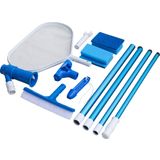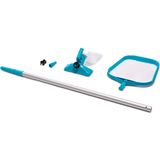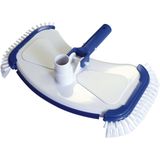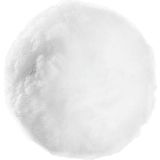A Comparison of Pool Vacuum Cleaners
Properties of a good pool vacuum cleaner
A good vacuum cleaner should remove as much dirt as possible from your pool in a reasonable amount of time. It should be able to suck up the dirt from the pool floor without stirring it up and sending clouds of dirt swirling through the pool water. Ideally, a pool vacuum should not only suction leaves and other larger dirt particles, but also permanently remove very fine particles from the water. This will help improve the water quality in your pool so you can enjoy splashing around in your pool more. When it comes to operation, it should lighten your workload, not add to it.
What types of pool vacuum cleaners are available
There are different types and categories of pool vacuum cleaners:
- manual vacuum cleaners that are operated via the filter system
- manual vacuum cleaners that are operated with a garden hose
- manual vacuum cleaners powered by a built-in rechargeable battery
- Pool robots powered by the filter pump
- Pool robots with mains power
- Pool robots powered by battery
- Pool robots that not only clean the pool floor but also the walls and, if necessary, the waterline
How do pool vacuum cleaners differ?
a) Degree of completeness
Some devices come with everything needed to operate and can be used right away. Other pool floor vacuum cleaners need extra accessories. Here are some examples:
- The Steinbach Basic Cleaning Set includes a manual vacuum cleaner that needs an extra garden hose for operation, just like the Intex Venturi Cleaning Set.
- The Steinbach Deluxe Manual Vacuum Cleaner requires both a hose, a telescopic rod and a filter pump to which it must be connected.
- The Intex underwater handheld vacuum cleaner comes with a telescopic rod, attachments and a charging cable. But not included is the power supply unit or charger - you must supply the USB charger.
b) Pool vacuum cleaner accessories
Some pool vacuum cleaners and pool robots comes with some accessories included. Usually these include different filter inserts (e.g. coarse and fine filters), attachments with different suction surfaces or brush attachments. Some manual vacuum cleaners often include a suction hose and/or a telescopic rod.
Comparing different pool floor vacuum cleaners
Let's compare some models.
a) Vacuum cleaners for manual cleaning
These vacuum cleaners must be operated by hand. But there are some differences in usage and the cleaning process itself.
Venturi vacuum cleaners for pools
Pool vacuum cleaners that work on the Venturi principle and garden hose are very economical. With such a device, you can achieve a more or less clean pool floor but it's not perfect. Plus, depending on the duration, new water gets added to the pool which can change the water values a little. Examples are the Steinbach basic cleaning set mentioned above and the Intex Venturi Cleaning Set. They will not perform miracles and you should use them only for a pool floor area of up to 8m².
Pump-operated pool floor vacuum cleaners
Cleaners like this are available in different models. Our favourite here is the Intex Deluxe Cleaning Kit. Compared to other floor vacuums in this category, this vacuum cleaner can be attached to the inner pool wall on Bestway and Intex pools. This enables operation without self-priming filter pumps because the water is drawn into the pump on its own. This pool vacuum also only needs 2.7m³ net pump capacity to achieve very good to excellent results when cleaning the pool with the narrow attachment. For the large attachment, however, your cartridge filter system or sand filter system needs a net pump capacity of 4.5 m³ for best results. The advantage with such a powerful pump is that with this combination, even medium-sized pools up to 22m² can be cleaned effectively within a reasonable amount of time. Another reason why we recommend this Intex pool cleaner model is that the device itself does not move. It stays in a fixed spot while cleaning your pool and cannot tip over accidentally - which is good!
Cordless vacuum cleaner
The special feature of such vacuum cleaners is that they don't need to be set up or taken apart. Simply submerge it, switch it on and off it goes! This is ideal if you want to do a quick clean up at any time. The Intex underwater vacuum cleaner has some additional features that make it popular with pool owners:
- achieve extremely good cleaning results with a narrow suction attachment without brushing
- a sturdy telescopic rod is included in the delivery
- can also be attached to other telescopic rods (3 cm) using the enclosed adapter
- reasonable price
- very fine micro-filter gets most dirt filtered
- cleaning performance can be improved with filter balls - it can suction up even finer particles when compared to the fine micro bag
- does not cause turbulence when used slowly
But the Intex underwater handheld vacuum cleaner also has its limitations. The suction power is only very good with the small suction attachment without the brushes. The suction power is considerably reduced with the brushes or the large attachment with rows of brushes on the underside.
b) Pool robots
These are automated pool floor vacuum cleaners that are very suitable for pool maintenance. The most important feature of pool robots is that they significantly reduce the amount of work you have to put in when cleaning your pool. Let's look at the various types:
Automated pool vacuums powered by a pump
There are several models available of which the three most popular are:
- Auto Pool Cleaner ZX50 - for pools with 32 mm connections
- Intex Auto Pool Cleaner 28001 - for pools with 38 mm Intex connections
- Intex Delxue Auto Pool Cleaner ZX300 - for pools with 38 mm Intex connections (also cleans the walls)
Note that these pool vacuums have different hose connections. The ZX50 model is only suitable for Intex round pools up to 457 cm in diameter and rectangular pools with a maximum length of 488 cm. The filter system should have a net output between 2,700-4,400 L/h (gross: 3,400 - 5,700 L/h). The 28001 and Zx300 models can only be used with larger Intex pools. These vacuum cleaners need powerful pumps to work properly. The output needed here is between 6,000 and 13,250 L/h gross. Tip: If your sand filter has a gross capacity of just under 6,000 L (many devices have a gross capacity of 5,700 L), then set the sand filter valve to "circulate" - this will significantly increase the performance of your filter pump. Since both Intex pool vacuum cleaners work on the pressure-feed system, such an approach is not a disadvantage.
Electrically powered pool robots
These products can have huge differences. First thing to consider is the absolute suction power - more is better! The higher the suction power the better is the dirt removal performance. But speed is also an important factor but here, less is better! When they move slowly, they stir up less dirt and suction up dirt more thoroughly. Our favourites are: Steinbach Twin pool cleaner and Steinbach Pool Cleaner with App. They are a little slower than smaller models but have an extremely powerful suction pump. The cleaning results are excellent. Plus, they clean the pool walls as well as the waterline (to be precise: 3-4 cm above it). But these pool robots are more expensive and weigh significantly more than smaller devices.
Pool floor vacuums - how they help with pool maintenance
Many pool owners are not aware that pool vacuum cleaners not only improve the appearance of your pool and garden but also improve pool water quality and reduce the use of pool chemicals. Remember that debris such as dust, leaves, pollen and insects are a breeding ground and source of nutrition for microorganisms. Removing these particles permanently from your pool water with a vacuum cleaner also removes the microorganisms living on them as well as potential food sources for them. Furthermore, with the regular use of such a pool cleaner, you will need less chlorine because there are fewer targets in the pool for the chlorine to tackle.
Tips for best results
- You can get great results even with a reasonable budget. If the suction power is not very high, use the smallest attachment possible.
- Pump-powered models require fully deflated pool hoses otherwise their performance will be greatly reduced. Unless you're using a self-priming pump, it only sucks air.
- If possible, place filter balls in your pool vacuum cleaner. You can get excellent filtration results because filter balls can go down to 1.5 microns.
- In case of cordless vacuum cleaners, remember to recharge them fully after every use. Don't operate for too long (foe instance, the Intex underwater vacuum cleaner should be used for a maximum of 50 minutes at a time). You can protect the battery from damage by combining these two measures.
- In case of excessive algae growth, loosen all algae manually with a brush first before running your pool vacuum cleaner. Using filter balls is particularly beneficial in case of algae infestation because otherwise some algae spores and individual algae would not get filtered out.
- Dirt can flow right back into the water as a vacuum cleaner is removed from the pool. Each vacuum cleaner needs to be removed from the pool in a particular way to prevent the dirt from flowing back into the pool - experiment a little here.
Information about purchasing
In our online store we offer a variety of pool vacuum cleaners at great prices. We are committed to offering a wide assortment, great bargains and, of course, speedy shipping. 70% of all orders in Germany and Austria are delivered within a day. On each product page, you can find detailed information and specific features of each product to help you make the right choice. Enjoy browsing!
Related products
-
 4.4 (23)
4.4 (23)Steinbach Basic Cleaning Set, 1 Set
- For cleaning the water surface
- Floor and pool cleaning
- Robust telescopic pole
€ 38,67Delivery by December 13
-
 4.5 (24)
4.5 (24)Intex Venturi Cleaning Set, 1 Set
- For cleaning the water surface
- Floor and pool cleaning
- Simply connect to the garden hose
€ 35,20Delivery by December 13
-
 4.6 (14)
4.6 (14)Steinbach Floor Vacuum De Luxe, 1 Piece
- Loosens dirt, cleans and sucks
- With side brushes
- Holder for telescopic rod
€ 14,97Delivery by December 13
-
 4.8 (112)
4.8 (112)Steinbach Filter Balls, 700 g
- Large Filter Surface
- High Dirt Absorption Capacity
- Less Backwashing Processes
€ 23,30 (€ 33,28 / kg)Delivery by December 13

